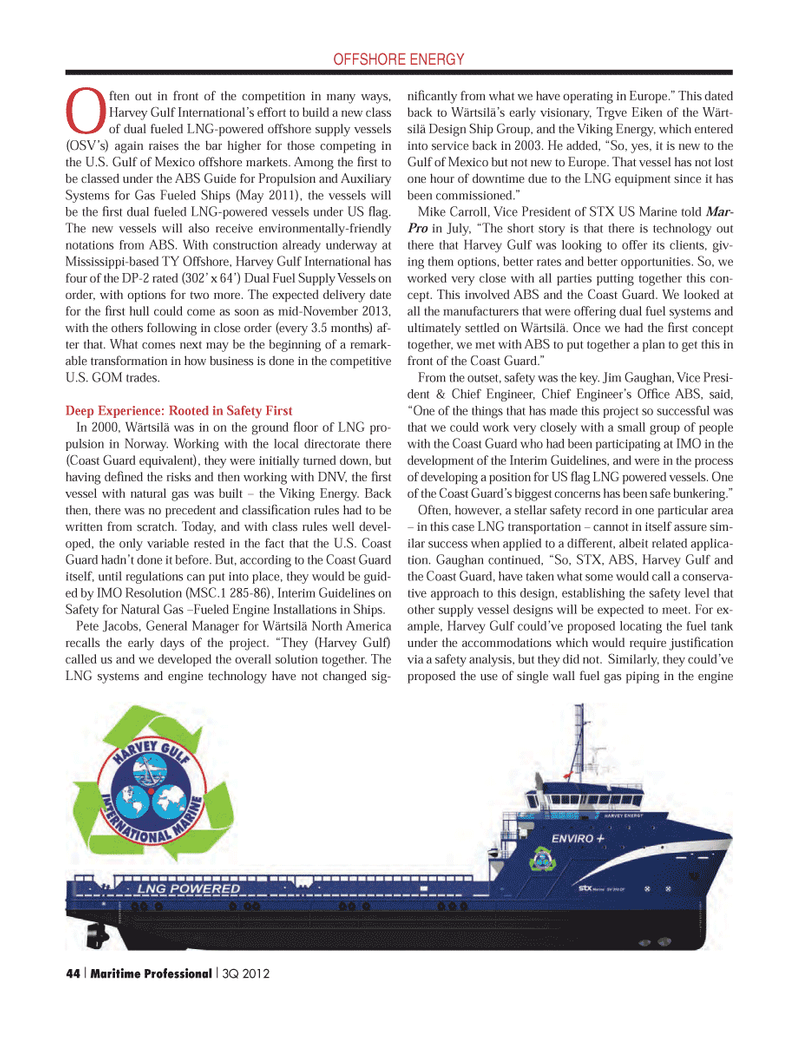
Page 44: of Maritime Logistics Professional Magazine (Q3 2012)
Classification Societies, Quality & Design
Read this page in Pdf, Flash or Html5 edition of Q3 2012 Maritime Logistics Professional Magazine
OFFSHORE ENERGYOften out in front of the competition in many ways, Harvey Gulf International?s effort to build a new class of dual fueled LNG-powered offshore supply vessels (OSV?s) again raises the bar higher for those competing in the U.S. Gulf of Mexico offshore markets. Among the rst to be classed under the ABS Guide for Propulsion and Auxiliary Systems for Gas Fueled Ships (May 2011), the vessels will be the rst dual fueled LNG-powered vessels under US ag. The new vessels will also receive environmentally-friendly notations from ABS. W ith construction already underway at Mississippi-based TY Offshore, Harvey Gulf International has four of the DP-2 rated (302? x 64?) Dual Fuel Supply Vessels on order, with options for two more. The expected delivery date for the rst hull could come as soon as mid-November 2013, with the others following in close order (every 3.5 months) af- ter that. What comes next may be the beginning of a remark- able transformation in how business is done in the competitive U.S. GOM trades. Deep Experience: Rooted in Safety First In 2000, Wärtsilä was in on the ground oor of LNG pro-pulsion in Norway. Working with the local directorate there (Coast Guard equivalent), they were initially turned down, but having de ned the risks and then working with DNV, the rst vessel with natural gas was built ? the Viking Energy. Back then, there was no precedent and classi cation rules had to be written from scratch. Today, and with class rules well devel- oped, the only variable rested in the fact that the U.S. Coast Guard hadn?t done it before. But, according to the Coast Guard itself, until regulations can put into place, they would be guid- ed by IMO Resolution (MSC.1 285-86), Interim Guidelines on Safety for Natural Gas ?Fueled Engine Installations in Ships.Pete Jacobs, General Manager for Wärtsilä North America recalls the early days of the project. ?They (Harvey Gulf) called us and we developed the overall solution together. The LNG systems and engine technology have not changed sig- ni cantly from what we have operating in Europe.? This dated back to Wärtsilä?s early visionary, Trgve Eiken of the Wärt- silä Design Ship Group, and the Viking Energy, which entered into service back in 2003. He added, ?So, yes, it is new to the Gulf of Mexico but not new to Europe. That vessel has not lost one hour of downtime due to the LNG equipment since it has been commissioned.? Mike Carroll, Vice President of STX US Marine told Mar-Pro in July, ?The short story is that there is technology out there that Harvey Gulf was looking to offer its clients, giv- ing them options, better rates and better opportunities. So, we worked very close with all parties putting together this con- cept. This involved ABS and the Coast Guard. We looked at all the manufacturers that were offering dual fuel systems and ultimately settled on Wärtsilä. Once we had the rst concept together, we met with ABS to put together a plan to get this in front of the Coast Guard.? From the outset, safety was the key. Jim Gaughan, Vice Presi- dent & Chief Engineer, Chief Engineer?s Of ce ABS, said, ?One of the things that has made this project so successful was that we could work very closely with a small group of people with the Coast Guard who had been participating at IMO in the development of the Interim Guidelines, and were in the process of developing a position for US ag LNG powered vessels. One of the Coast Guard?s biggest concerns has been safe bunkering.? Often, however, a stellar safety record in one particular area ? in this case LNG transportation ? cannot in itself assure sim-ilar success when applied to a different, albeit related applica- tion. Gaughan continued, ?So, STX, ABS, Harvey Gulf and the Coast Guard, have taken what some would call a conserva- tive approach to this design, establishing the safety level that other supply vessel designs will be expected to meet. For ex- ample, Harvey Gulf could?ve proposed locating the fuel tank under the accommodations which would require justi cation via a safety analysis, but they did not. Similarly, they could?ve proposed the use of single wall fuel gas piping in the engine 44 I Maritime Professional I 3Q 2012

 43
43

 45
45
